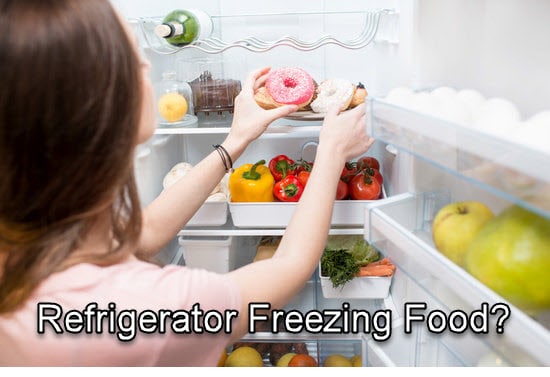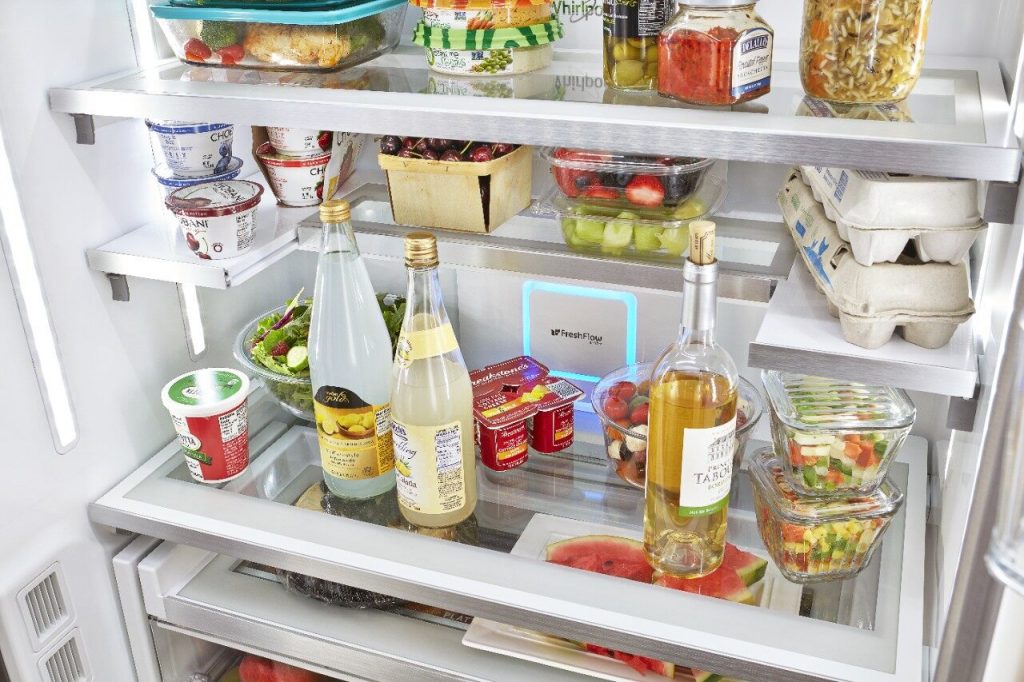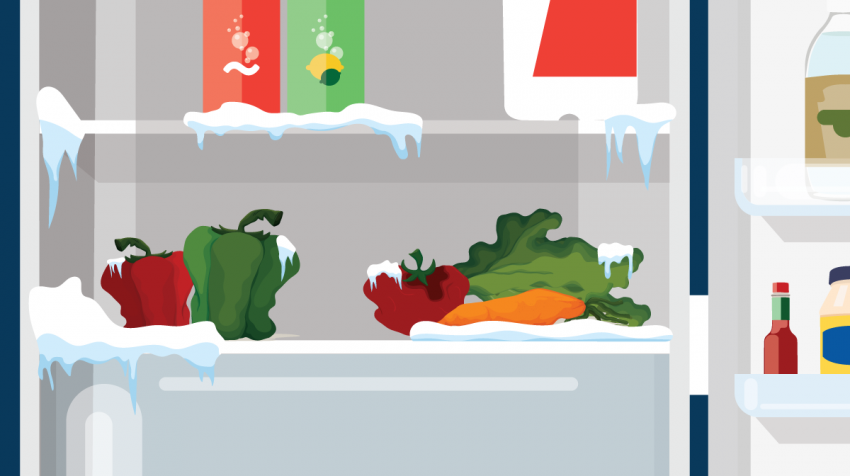Have you ever put milk, eggs, fruit, vegetables, meat, or other things in the freezer only to find your freezer is freezing food? It can be disconcerting to open the fridge in the morning and find that the bottle of milk you put in the fridge yesterday is now frozen solid. While this problem is a bit rare, it can happen, and it’s definitely a sign that something’s wrong with your refrigerator. Here are 5 reasons why your device may be freezing everything and how to fix it.
Table of Contents
Why is Your Refrigerator Freezing Food

- You set the thermostat too high
Thermostats on refrigerators are easy to move, and when you load groceries or move things out of the refrigerator, the thermostat can accidentally turn on. If you don’t think the refrigerator is cold enough, you might turn up the thermostat on purpose. Most refrigerators have a marking on the thermostat adjustment knob, but this marking is removed over time. This means that there is no longer an accurate way to measure the indicated temperature. So you may have set your thermostat higher than expected, which not only causes everything to freeze but also higher energy consumption and a bigger bill.
- Your gasket is broken
Gaskets are the lining of the refrigerator door, creating a seal for the compartment and preventing heat exchange between the room and the inside of the refrigerator. If the seal is damaged and leaks, your refrigerator will keep running to compensate, which will cause everything inside to start freezing. There is an easy way to test if you have a bad gasket; clamp the door with a piece of paper and pull it out without opening it. If the paper slips out easily or won’t hold, the gasket is bad and needs to be replaced.
- Your coil is dirty
In addition to the evaporator coil inside the unit, the heat exchanger and condenser coil are also installed outside the refrigerator. These coils are needed to allow the refrigerant fluid to perform its heat exchange duties. When those coils are covered in dust or other forms of grime, it forces the refrigerator to work harder and harder to maintain optimal temperatures. Unfortunately, this can sometimes lead to supercooling and the effects of winter in the refrigerator. Cleaning the coil is fairly straightforward; you can find instructions in the owner’s manual, and it’s a good idea to clean it regularly to avoid problems in the future.
- Your thermostat is faulty
Thermostats are designed to trigger cooling when necessary. In the refrigerator, once the set temperature is reached, it will automatically stop working. This is essential to maintain the desired fixed temperature. When the thermostat fails, it may fail to shut down, causing the thermostat to keep running.
- Damper problem
If you own a refrigerator, you’re probably familiar with dampers. This is basically the component needed to regulate the amount of cooling air going from the freezer into the refrigerator. If the damper fails, excess air may flow into the refrigerator compartment, causing the temperature to drop gradually. If you suspect you may have a shock absorber problem, you need the expertise of an experienced appliance repair specialist.
If you have a problem with your refrigerator, a professional appliance repair specialist can provide an effective and long-lasting solution. To get help with all your refrigerator repair needs, be sure to consult a professional appliance repair service.
How To Keep Your Refrigerator From Freezing Food

Reset Refrigerator Temperature
If your refrigerator is too cold, find the temperature controller and adjust it accordingly. Not sure which temperature is correct? Please refer to the user guide or user manual.
You may find that your refrigerator is set at an ideal setting for cooling food, but your temperature sensor may still be off. To manually check the refrigerator temperature, place a glass of water on the top shelf of the refrigerator for 24 hours. Remove the glass and test the water temperature with a cooking thermometer. If the thermometer reading is not within 2 degrees of the set temperature or recommended temperature range, the refrigerator’s temperature sensor may be faulty and needs to be replaced.
Rearrange Your Food
Make sure the food in the refrigerator doesn’t hit any of the vents. You can also try to distribute food more evenly in the refrigerator. To learn more about how to store food in the refrigerator, check out our refrigerator organization guide.
Check Your Refrigerator’s Door Gasket
If you suspect a refrigerator door may be leaking, take some time to clean and inspect the door seal. If they are torn, twisted, or frayed, replace them immediately. With these replacement parts from Whirlpool, you can not only prevent your refrigerator from freezing food, but also save energy.
Adjust Ice Maker Settings
If you suspect a refrigerator door may be leaking, take some time to clean and inspect the door seal. If they are torn, twisted, or frayed, replace them immediately. With these replacement parts from Whirlpool, you can not only prevent your refrigerator from freezing food, but also save energy.
Change the Temperature Gauge
The refrigerator has a thermometer that allows the user to adjust the temperature of the unit. The gauge might look like a dial, or on newer models, it might be a digital display. There are usually numbers on the dial, with one indicating the hottest and the highest number indicating the coldest. Setting the thermometer to zero means the thermometer is off. A digital display usually shows the actual temperature.
Adjust the dial or digital display according to the refrigerator’s instructions. The temperature in the refrigerator should remain around 40°F (4.44°C). Allow 24 hours to pass before readjusting the meter, then check the food. If the food continues to freeze in the refrigerator, adjust the meter again and wait another 24 hours.
If food continues to freeze, place a separate thermometer in the unit for a more accurate reading.
Ensure the Door Magnets Still Work
The refrigerator door uses “permanent magnets” to keep the door fully closed. These magnets ensure a tight seal, preventing cold air from escaping and hot air from entering. However, in rare cases, refrigerator seals may lose their magnetism, “permanently” or not.
When the refrigerator seals are not working properly, when hot air enters, it can cause frost in the refrigerator.
Open the refrigerator door and close it gently. Does it form a safety seal? If the door doesn’t seem to close completely, or if the refrigerator starts to open on its own shortly after closing, the magnets may be too weak.
It could also be that the seals are dirty. In this case, a little mild detergent and water will do the trick. If the magnet appears worn, twisted, or generally not working, replace it immediately.
Cleaning the Refrigerator Coils
Refrigerators utilize coiled tubes to cool and condense freon or other refrigerants. The user must keep the refrigerator coil free of dirt, debris, and dust to ensure it works properly. When these coils are clogged, they can’t release heat efficiently, so the compressor works harder to keep the temperature low enough. In some cases, the refrigerator works too hard, and the result is frozen food and beverages.
To clean refrigerator coils:
- Unplug the refrigerator. Do not open the door after unplugging. The refrigerator should be able to stay cool enough as long as the door is closed until you finish cleaning the coils.
- Move the refrigerator away from the wall. Go into the back of the refrigerator to see the coils. If you are not sure where the coil is, please refer to the manual.
- Use an air duster spray can blow away dust and debris. Vacuum up any remaining dust.
- Wipe the coil with a clean cloth. Keep in mind that the coils can be hot, so use caution and wear heat-resistant gloves.
- Move the refrigerator back to its original position. Plug it in. Take at least an hour before opening the refrigerator door to ensure the refrigerator has time to cool.
Replace the Thermostat
Not all refrigerators last forever. The older the equipment, the more likely it will require maintenance and replacement parts. A refrigerator thermostat is a common component that tends to break down after a few years.
Once the refrigerator reaches the desired temperature, the thermostat lets the compressor know it’s time to stop cooling. However, sometimes these thermostats malfunction, causing excessive cooling when running continuously. Fortunately, refrigerator thermostats are relatively inexpensive and easy to replace.
As a temporary fix, you can use a contact cleaner to clean the contacts, but if the thermostat fails, you’ll still need to replace it later.
To replace the refrigerator thermostat:
- Move food to a safe place. A second refrigerator or freezer is ideal. Otherwise, don’t open the refrigerator door during this process to ensure the food stays cool.
- Unplug the refrigerator from the wall. Move the refrigerator away from the wall to allow access to the thermostat.
- Use your refrigerator manual to find your thermostat. Newer models often have thermostats on the back of the appliance. Older units put the thermostat on the bottom, under the refrigerator.
- Remove the thermostat cover. Use a screwdriver to remove the screws (some covers have clips). Set the clips or screws aside and cover.
Unplug the wire from the terminal. You’ll see two wires attached to the pin terminals on the thermostat. Remove it with needle-nose pliers.
Remove mounting screws or clips. After removing the screws or clips, it should be possible to pull the thermostat out of the evaporator tube.
Connect the new thermostat to the evaporator tube. Using needle-nose pliers again, gently connect the wires from the new thermostat to the pin terminals.
Replace the thermostat cover. Screw all screws back or reattach the clips. Plug the refrigerator into the wall. Adjust the temperature knob to test how well the new thermostat works.
Check Freezer Baffles
Some refrigerator models have a baffle in the freezer compartment. The damper acts like a flap that opens and closes to let air into the refrigerator.
Essentially, the baffles regulate the temperature of the refrigerator. If the damper is not working properly, excess cold air may enter the refrigerator. This lowers the temperature of the refrigerator, making food and drinks super cool and then freezing.
In some cases, food in the freezer may fall into the flap, preventing it from opening and closing. Check the shock absorber to make sure it is clear of obstructions. If it’s broken or stuck open, you’ll need to fix it.
If the refrigerator is under warranty, please contact the manufacturer. Otherwise, you will need to call a service person to check.
Check the control panel
Once the most common problems are ruled out, there are only a few more components to consider. The two most common control boards that can cause freezing are the main control board and the temperature control board.
While the control board is usually not the problem, that doesn’t mean it’s impossible for these components to fail. Still, it’s a good idea to check all other parts thoroughly before replacing these parts.
- Main control board
The main control board is unlikely to be defective, but it can happen. Having said that, it is important to check all other parts of the refrigerator first before replacing this expensive part. If you can’t find any other issues, the main control board might be the culprit
It is highly recommended that you hire a professional to replace the control board, especially if you are not sure what you are doing. To save money, you can start by ordering parts using your make and model.
- Temperature Control Board
Like the main control board, the temperature control board is less likely to fail, but it does sometimes. These control boards send power to the compressor and fan on the refrigerator. A defective control board can cause the compressor or fan to run continuously, causing the refrigerator to overcool.
Before replacing the temperature control board, check all other parts. Also, if the temperature control board needs to be replaced, consult a professional, especially if you have no experience with these parts.
Contact the manufacturer
If none of the above steps solve the problem, then the refrigerator may have a mechanical problem. These problems require professionals to solve. While the model is under warranty, you may get a free inspection. Please contact the manufacturer of your model. They may walk you through some troubleshooting steps first, and if the problem doesn’t resolve, they’ll send a technician.
If the refrigerator is not under warranty, you will need to have the appliance repair team inspect your refrigerator at your own expense.
Final Thoughts
Manufacturers design refrigerators to keep our food at a safe temperature. However, sometimes these appliances malfunction and end up with our food being too cold. If your refrigerator is freezing food, try changing the thermometer, rearranging the food, adjusting the freezer temperature, checking the magnets, cleaning the coils, changing the thermostat, or checking the baffles. If all else fails, contact a trusted technician.

